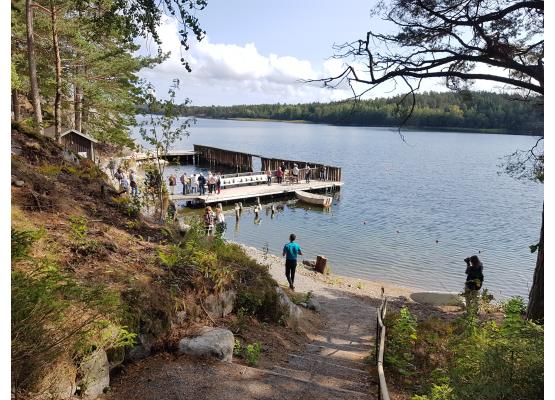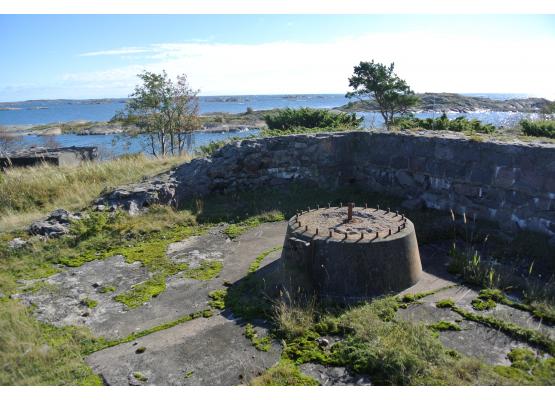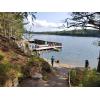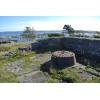In English
Historical traces
The Gålö nature reserve is located in Stockholm's southern archipelago. In the 1940s, secret activities took place here in a very secluded place. Seals were trained to detect submarines (!), and 19 out of 20 seals managed to learn it.
When the business was eventually closed down, the constructions began to decay.
Today, Gålö seal station is managed by the Archipelago Foundation in Stockholm County.
- Through the DefenceArch project, we were able to renovate and bring this special story to life. Now we have a tourist facility with many visitors where the site's military history is an important part of the experience, says Pia Berg, project manager at the Archipelago Foundation.
- For me, this project was like a big archeology study. We rediscovered the exciting history through archival research, by searching for old newspaper articles, watching TV features from the 80s and interviewing people who experienced the seal station when the business was running.
Research students conducted a marine archeological survey and a metal detector survey of the land area, which provided additional clues.
Pia continues:
- When we started the renovation on site, we saw that some things had changed since the 1940s, but there were still a lot of buildings and structures from that time. We restore the physical environment, and now we can use an app and information boards to highlight the exciting story of the place where it took place. The houses, the stairs, the cement corridors and the seal pool make everything come alive and very tangible for the visitor.
Increased accessibility
Örö island in Kimito, far out in the Turku archipelago, is another place that has been given new life. For a long time, the area belonged to the Finnish army, and the public had no access. Here the military, war prisoners and conscripts lived under vulnerable conditions for long periods. You can still catch a glimpse of the life at Örö through the paved roads. One bears the name "Pitkä ikävä" (long longing/ great boredom).
Now the Metsähallitus manages the island, and the visitor pressure has been great. This EU project made history more accessible. The southern cape was previously unused area and has now been more user-friendly. Now you can receive more and different types of visitors: bunkers have been opened up, cannons testify to history, and a suspension bridge connects the area. The old buildings are now exhibition areas and guest houses.
The DefenceArch project brought history to life not only on Gålö and Örö but also in Korpoström in Parainen and Bomarsund on Åland.
Everything is gathered in the app Coastal Past.
På svenska
Historien lämnar spår
Naturreservatet Gålö ligger i Stockholms södra skärgård. På 1940-talet pågick här hemlig verksamhet på en mycket undanskymd plats. Sälar tränades nämligen för att upptäcka ubåtar (!), och 19 av 20 sälar lyckades lära sig det. När verksamheten lades ned började konstruktionerna förfalla.
Idag förvaltas Gålö sälstation av Skärgårdsstiftelsen i Stockholms län.
Topphemlig historia är en viktig del av upplevelsen
- Genom projektet Defence Arch kunde vi renovera och levandegöra den här speciella historien. Nu har vi en turistanläggning med många besökare där platsens militärhistoria är en viktig del av upplevelsen, berättar Pia Berg, projektledare vid Skärgårdsstiftelsen.
- För mig var det här projektet som en stor arkeologiundersökning. Vi återupptäckte den spännande historien genom arkivforskning, genom att söka efter gamla tidningsartiklar, titta på TV-inslag från 80-talet och intervjua personer som upplevde sälstationen när verksamheten var igång.
Forskarstudenter gjorde en marinarkeologisk undersökning och en metalldetektorundersökning av landområdet, vilket gav ytterligare ledtrådar.
- När vi började renoveringen på plats såg vi att en del var förändrat sedan 1940-talet, men det fanns fortfarande mycket kvar av byggnader och konstruktioner från den tiden. Vi återställer den fysiska miljön, och nu kan vi med hjälp av en app och informationstavlor lyfta fram den spännande historien på den plats där den utspelade sig. Husen, trapporna, cementgångarna och sälbassängen gör att allting blir levande och väldigt påtagligt för besökaren.
Ökad tillgänglighet synliggör försvarshistoria
Ön Örö i Kimito långt ut i den åboländska skärgården är en annan plats som fått nytt liv. Det var länge försvarets område, dit privata inte hade tillträde. Här levde militärer, krigsfångar och beväringar i utsatt läge under långa perioder. Hur livet gestaltade sig kan de stenlagda vägarna fortfarande ge en vink om. En bär namnet ”Pitkä ikävä” (lång längtan/stor leda).
Nu förvaltar Forststyrelsen ön, och besökartrycket har varit stort. Genom detta EU-projekt har man gjort historien mer tillgänglig. Den södra udden var tidigare outnyttjat område. Nu kan man ta emot fler och olika typer av besökare. Bunkrar öppnas upp, kanoner vittnar om historien, och en hängbro binder samman området. De gamla byggnaderna är nu utställningsutrymmen och gästbostäder.
Projektet DefenceArch har levandegjort historia inte bara på Gålö och Örö utan också i Korpoström i Pargas och Bomarsund på Åland.
Allt finns samlat i appen Coastal Past.








